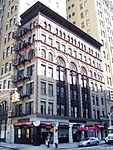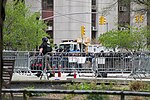Firehouse, Engine Company 31
1895 establishments in New York (state)Defunct fire stations in New York (state)Fire stations completed in 1895Fire stations in New York CityFire stations on the National Register of Historic Places in New York (state) ... and 4 more
Government buildings on the National Register of Historic Places in ManhattanManhattan Registered Historic Place stubsManhattan building and structure stubsNew York City Designated Landmarks in Manhattan

Firehouse, Engine Company 31 is a historic fire station located at 87 Lafayette Street between Walker and White Streets in the Civic Center neighborhood of Manhattan, New York City. It was built in 1895 and designed by architects Napoleon LeBrun & Sons, who built it in the style of chateau in the Loire Valley of France from the early 16th-century.The building was designated a New York City Landmark in 1966 and added to the National Register of Historic Places in 1972. The fire department vacated the building in November 1972, and it is currently occupied by the Downtown Community Television Center (DCTV).
Excerpt from the Wikipedia article Firehouse, Engine Company 31 (License: CC BY-SA 3.0, Authors, Images).Firehouse, Engine Company 31
White Street, New York Manhattan
Geographical coordinates (GPS) Address Nearby Places Show on map
Geographical coordinates (GPS)
| Latitude | Longitude |
|---|---|
| N 40.717222222222 ° | E -74.001388888889 ° |
Address
White Street 101
10013 New York, Manhattan
New York, United States
Open on Google Maps









